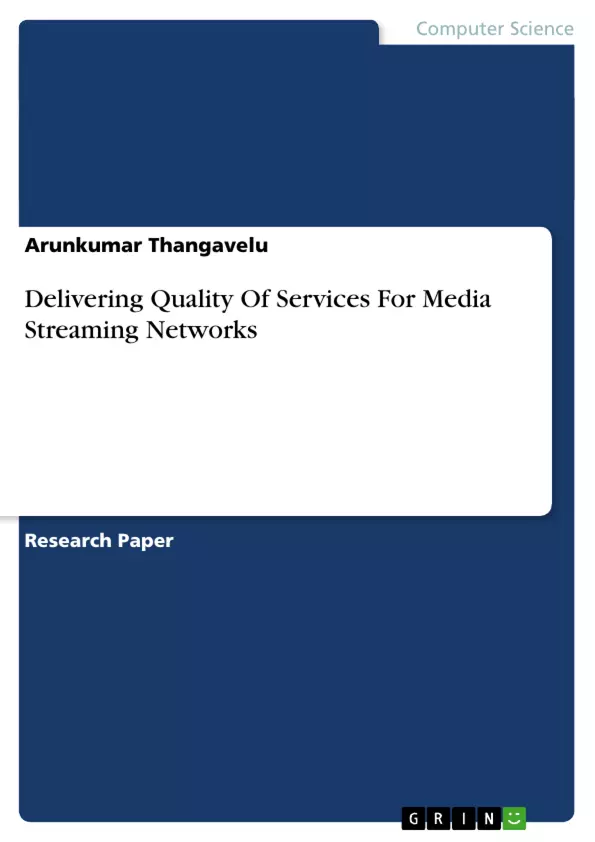One of the major challenges faced by MANET researchers is the deployment of end-to-end quality-of-service support mechanisms for streaming media services over a group of MANET users. Group-oriented services over large, dynamically changing MANET networks has a big impact on the needs of streaming services communication in terms of mobility, quality of service (QoS) support and multicasting.
In MANET networks, where such features are not embedded with its architecture, it is necessary to develop QoS multicasting strategies. The research work focuses on the basic building blocks of an mobile ad hoc group communication scheme, which achieves multicasting optimal QoS efficiency OptiQ by tracking resource availability in a node’s neighborhood based on resource reservations, which announces the required QoS before each session initiation.
The primary quality of service (QoS) issues such as required bandwidth, message delay, traffic type and hop count per route improves the efficiency of streaming services over ad-hoc network. Streaming services support voice, data and video traffic by assessing and adjusting for various levels of QoS. The performance analysis is performed on functional prototype of OptiQ in mobile / wireless ad-hoc network with emphasis on service satisfaction for multiple group conference sessions.
The performance of OptiQ scheme is well compared with QoS-aware versions of AODV and TORA, well-known ad-hoc routing and limited QoS protocols. Using the SPRUCE bandwidth traffic gathering tool, with a set of C++ modules an extensive set of performance experiments were conducted for these protocols with OptiQ on a wide variety of mobility patterns and reservation strategies. The results shows the performance analysis of OptiQ is better than AODV or TORA protocol in minimizing end-to-end delay and controlling loss.
Inhaltsverzeichnis (Table of Contents)
- I. INTRODUCTION
- II. RELATED WORK
- A. Review Stage.
- B. Challenges
- A. Route Discovery.
- B. Routing Table Update
- C. Alternate Route on Repair.
- D. Route Deletion.........
- III. QASAN Architecture.
- QASAN Group Create / Modify..
- IV. QASAN Policy Manager (OPTIQ_Policy).
- V. QoS Simulation Evaluation Metrics
- A. Capacity estimation
- B. Delay estimation.....
- C. Admission control and resource reservation
- VI. Experimental Test Bed Preparation .......
- A. Hardware Setup Used .....
- B. Performance & Evaluation
- VII. Summary..
- REFERENCES.
Zielsetzung und Themenschwerpunkte (Objectives and Key Themes)
This paper explores the challenges of delivering quality-of-service (QoS) support for streaming media services in ad hoc group communication networks. It aims to develop a novel scheme, QASAN, that effectively addresses these challenges and ensures efficient and reliable delivery of media content in dynamic environments. The paper focuses on the importance of QoS for streaming services in mobile ad hoc networks, especially considering the impact of mobility, QoS support, and multicasting.
- Quality of Service (QoS) in Ad Hoc Networks
- Streaming Media Services in Group Communication
- Multicasting and Resource Management
- QoS-aware Routing and Policy Management
- Performance Evaluation and Experimental Validation
Zusammenfassung der Kapitel (Chapter Summaries)
The introduction outlines the importance of QoS routing for multimedia distribution in high-speed networks and highlights the challenges of guaranteeing QoS in mobile ad hoc environments. It discusses the limitations of existing QoS protocols and introduces the concept of Soft QoS as a potential solution for handling dynamic network conditions.
Chapter II provides a comprehensive review of existing research related to QoS routing and group communication in ad hoc networks. It analyzes the challenges and shortcomings of existing protocols, such as AODV and TORA, and emphasizes the need for more robust and efficient solutions.
Chapter III presents the proposed QASAN architecture, which addresses the challenges of QoS provisioning for streaming services in ad hoc group communication networks. It describes the key components of QASAN, including its group creation and modification mechanisms, and the role of the QASAN Policy Manager (OPTIQ_Policy) in ensuring QoS guarantees.
Chapter IV delves into the details of the QASAN Policy Manager (OPTIQ_Policy) and its negotiation procedures. It outlines the policies used for resource allocation and reservation, focusing on the optimization of QoS for various types of streaming services.
Chapter V discusses the simulation evaluation metrics used to assess the performance of QASAN. It examines the aspects of capacity estimation, delay estimation, admission control, and resource reservation, highlighting the importance of these factors in achieving reliable QoS for streaming services.
Schlüsselwörter (Keywords)
Quality of Services, Streaming Services, Ad Hoc Networks, group communication, QoS Routing, Multicasting, Resource Management, OptiQ_Policy, Performance Evaluation, AODV, TORA, SPRUCE.
- Citar trabajo
- Dr. Arunkumar Thangavelu (Autor), 2007, Delivering Quality Of Services For Media Streaming Networks, Múnich, GRIN Verlag, https://www.grin.com/document/72844



